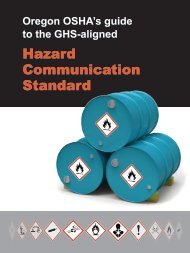Technical Manual - Section 3 (Safety Hazards)
Technical Manual - Section 3 (Safety Hazards)
Technical Manual - Section 3 (Safety Hazards)
You also want an ePaper? Increase the reach of your titles
YUMPU automatically turns print PDFs into web optimized ePapers that Google loves.
Figure III:2-23 Molecular Sieve Drying and Sweetening<br />
HEALTH AND SAFETY CONSIDERATIONS<br />
Fire Protection and Prevention<br />
The potential exists for fire from a leak or release of feedstock<br />
or product. Sweetening processes use air or oxygen. If excess<br />
oxygen enters these processes, it is possible for a fire to occur<br />
in the settler due to the generation of static electricity, which<br />
acts as the ignition source.<br />
Health<br />
Because these are closed processes, exposures are expected<br />
to be minimal under normal operating conditions. There is a<br />
potential for exposure to hydrogen sulfide, caustic (sodium<br />
hydroxide), spent caustic, spent catalyst (Merox), catalyst<br />
dust and sweetening agents (sodium carbonate and sodium<br />
bicarbonate). Safe work practices and/or appropriate personal<br />
protective equipment may be needed for exposures to<br />
chemicals<br />
and other hazards such as noise and heat, and during process<br />
sampling, inspection, maintenance, and turnaround activities.<br />
UNSATURATED GAS PLANTS<br />
Unsaturated (unsat) gas plants recover light hydrocarbons (C 3<br />
and C 4 olefins) from wet gas streams from the FCC, TCC, and<br />
delayed coker overhead accumulators or fractionation<br />
receivers. In a typical unsat gas plant, the gases are<br />
compressed and treated with amine to remove hydrogen<br />
sulfide either before or after they are sent to a fractionating<br />
absorber where they are mixed into a concurrent flow of<br />
debutanized gasoline. The light fractions are separated by<br />
heat in a reboiler, the offgas is sent to a sponge absorber, and<br />
the bottoms are sent to a debutanizer. A portion of the<br />
debutanized hydrocarbon is recycled, with the balance sent to<br />
the splitter for separation. The overhead gases go to a<br />
depropanizer for use as alkylation unit feedstock.<br />
III:2-43
















